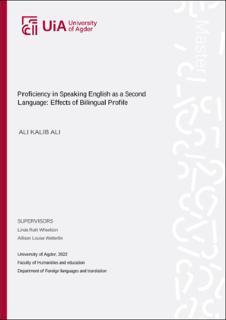| dc.description.abstract | This study examines how aspects of bilingual profile, particularly learning and exposure in L2 English, relate to aspects of L2 spoken proficiency. Norwegian-English bilinguals completed a questionnaire describing their language background, proficiency, learning, and exposure in their L2 English. Next, participants performed a vocabulary depth task determining correct similar or opposite words of a target word, after which they completed a sentence comprehension task at varying levels of syntactic complexity determining the correct answer to questions referring to either the agent or patient in the sentence structure. Additionally, participants performed one of four novel partially controlled picture description tasks in which they verbally described what they saw. Results showed that learning and exposure to L2 English increased fluency measures, such as speech rate. Moreover, learning by gaming also influences fluency in that it induces shorter speaking time but enhances the compactness of the speech. Moreover, results indicate that L2 English learning and exposure through school does not enhance fluency, while exposure through friends does. Furthermore, exposure to L2 English through family hinders increased proficient fluency. | |
